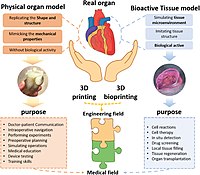
Photo from wikipedia
A major limitation in extrusion-based bioprinting is the lack of direct process control, which limits the accuracy and design complexity of printed constructs. The lack of direct process control results… Click to show full abstract
A major limitation in extrusion-based bioprinting is the lack of direct process control, which limits the accuracy and design complexity of printed constructs. The lack of direct process control results in a number of defects that can influence the functional and mechanical outcomes of the fabricated structures. The machine axes motion cannot be reliably used to predict material placement, and precise fabrication requires additional sensing of the material extrusion. We present an iteration-to-iteration process monitoring system that enables direct process control in the material deposition reference frame. To fabricate parts with low dimensional errors, we integrate a non-contact laser displacement scanner into the printing platform. After fabrication of the initial print using the as-designed reference trajectory, the laser scanner moves across the part to measure the material placement. A custom image processing algorithm compares the laser scanner data to the as-designed reference trajectory to generate an error vector. To compensate for the measured error, the algorithm modifies the axes reference trajectory for the second print iteration. We implement the in situ process monitoring and error compensation technique on an experimental platform to evaluate system performance and demonstrate improvement in spatial material placement.
Journal Title: Biofabrication
Year Published: 2019
Link to full text (if available)
Share on Social Media: Sign Up to like & get
recommendations!